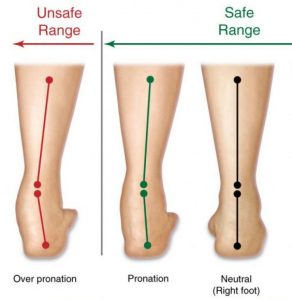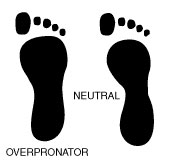The shape of the human foot and its mechanics are designed to minimize the stress of walking or running. When your foot pushes off, it propels you forward by rolling outward or supinating. When it strikes the ground again, it absorbs the shock of impact by rolling inward or pronating.
This process is normal and healthy. In fact, it’s crucial to protect your joints over the long haul. But when your foot rolls inward a little too much, that’s when you can start to have problems. This is called overpronation, and it’s the leading cause of most runners’ injuries.
Overpronation can destabilize your body when walking and running

- Achilles tendinitis
- Heel spurs
- Plantar fasciitis
- Shin splints
Overpronation can also play a role in acute injuries, like ankle sprains.
Are you an overpronator?
Overpronation isn’t always obvious. Most people take the way that they walk or run for granted. You can always have your gait analyzed by a foot and ankle specialist, but there are some ways to tell at home.
Flat feet
First, overpronators typically have flat feet and extremely flexible arches. That excessive movement makes it hard for your body to support your weight while running.
Wet foot test

Next, step onto a newspaper or paper bag. If your footprint leaves you asking “what arches?” then you’re probably an overpronator.
Wear and tear on your shoes
You can also tell from the wear and tear on your shoes. Flip your running shoes over. If the heel and ball of the foot leading into the big toe are all worn in, then overpronation is the likely culprit.
How to correct for overpronation
So, you’re an overpronator? Don’t worry; you’re in good company! Livestrong.com estimates that 20-30% of runners are severe overpronators, while up to 60% are mild overpronators. Keep reading to learn how to reduce your risk of injury.
Supportive shoes
To keep your arches from collapsing with every step, you need sturdy, supportive footwear. Shoes with proper arch support will keep your foot in alignment and give you stability. Avoid any shoes with flexible soles, especially trendy “minimalist” shoes.
Even if you get brand new, motion-controlling shoes, they may not be enough to correct the effects of overpronation. That’s why our doctors can’t recommend this next solution highly enough.
Custom insoles
Our patients LOVE their custom orthotic insoles. They’re specially fitted to your feet and tailored for your activity purposes. Insoles can both treat current injuries – like plantar fasciitis – and prevent new injuries from occurring.
According to a 2017 study published in the Journal of Biomechanics, custom insoles minimized the angle of pronation at ground strike and raised the height of the arch. “When feet are supported in correct alignment, also the position of the knees, pelvis, and hips are corrected, thereby providing a solid foundation for the entire body,” writes lead author Dr. J. Kosonen.
Forget the soft and foamy models you find at the drugstore. “What overpronators really need is structure,” said Dr. Bob Baravarian. “I’d recommend a semi-flexible plastic at a minimum, which can then be covered with a cushion for comfort.”
Tips to help pronate like the pros
Can’t afford new shoes or insoles at the moment? No sweat! There are steps you can take (see what we did there?) to reduce the impact of overpronation while you’re running.
Focus on your stride
Improving your form can help mitigate discomfort and prevent future injuries. Taking short, quick steps instead of long, drawn-out strides can minimize the foot’s rotation and decrease your chances of over-striding.
Stretches
You can also employ stretching and strengthening exercises (really, if you’re not already stretching after your runs, then you’re just asking for a stress injury).
Try some of these easy stretches that take five minutes or less.
Calf raises. Stand with your feet shoulder-width apart, toes pointed forward. Slowly, lift your heels off the ground and lower them back down. Repeat 10 times. You can even try these on one foot at a time.
Ball roll. Massage the arches of your feet with a golf ball or a frozen water bottle. Repeat with each foot for one minute.
Point, flex, curl. Sit on the floor with your legs straight out in front. Point the toes, then flex them back. Finish with a toe curl. Repeat this 10-12 times.
If you are experiencing problems with your feet or ankles we are here to help. Our nationally recognized podiatrists and foot and ankle specialists offer the most advanced foot and ankle care along with the highest success rates in the nation. We are leaders in the field of research and treatment of all foot and ankle conditions.
For more information or to schedule a consultation, please call (877) 736-6001 or visit us at www.footankleinstitute.com.
We are conveniently located throughout Southern California and the Los Angeles area. Our doctors are available at locations in or near: Santa Monica, Beverly Hills, West Los Angeles, Manhattan Beach, Sherman Oaks, Downtown Los Angeles, Westlake Village, Santa Barbara, and Valencia, California.
- What To Do When Your Toenail Is Falling Off - October 21, 2024
- How To Tell If You Have Wide Feet - October 3, 2024
- 15 Summer Foot Care Tips to Put Your Best Feet Forward - July 1, 2024
Leave a Reply